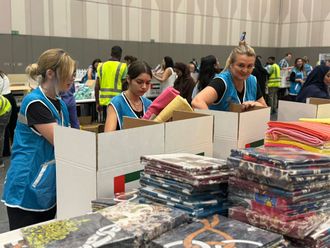
Dubai: Maths isn’t hard.
Teaching it is. And if students flunk in the subject, it’s mainly because of the poor teaching methods, say experts.
But there are a myriad ways to turn this around, a renowned math professor from the US told UAE teachers.
In the UAE, while students continue to improve in maths, the rankings leave more to be desired. In the last Trends in International Mathematics and Science Studies or TIMSS international assessments, the UAE stands 47th, and indicates that students are performing below international standards.
The UAE Vision 2021 National Agenda gives utmost importance to TIMSS testing and the goal of the UAE’s Ministry of Education is to have the UAE ranked in the top 15 countries for TIMSS by 2021.
Eric Schulz, who has been teaching mathematics in the US for more than three decades, trained around 50 professionals in the higher education sector on how to enhance teaching and learning math in the UAE.
A session titled ‘Math Day’ was organised by Pearson Middle East to address learning challenges with practical sessions to help accelerate how educators support their learners and strengthen the pipeline of STEM students in the UAE.
During the session, Schulz demonstrated how there is no reason for anyone to ‘hate’ or fear math. This perceived dislike stems from one’s lack of understanding of the subject and not really the subject itself, he said.
Schulz had this realisation around 12 years ago when a young man came to his office asking which maths class to take after saying, “I hate maths.”
Schulz then explored the student’s interests and decided to ask him to solve a problem using what he enjoys doing the most — visual arts. That offered a breakthrough.
“He had tears in his eyes. It was the first time that he had some understanding of what it meant to multiply those expressions because it connected with his visual processing. And that was a watershed moment for me,” Schulz told Gulf News.
“So now when somebody says ‘I hate maths,’ I don’t hear that they really hate maths. That’s a barrier maybe. It might just be that they don’t understand it.” So when there was an opportunity for Schulz to write an eText for Calculus and Pre-Calculus, he put this realisation in motion.
“I wanted to do something different. I think about mathematics in a very visual way. Mathematics moves, it dances. There’s interaction. And in the textbook, I saw an opportunity to make the book come alive as a way of reaching students that are not successful in maths because of the way in which we explain it with X’s and Y’s on a board,” Schulz said.
Close to 1,200 interactive figures were published in his two eTexts to make learning more engaging for students.
Vision on soft skills
Changing teaching techniques by making maths come to life with interactive graphics is key, say experts, especially as students choose their undergraduate courses in the UAE whether from STEM or other streams.
Dalia Leil, head of higher education portfolio strategy at Pearson Middle East, told Gulf News, “A critical point is now the vision and the mission of the UAE on soft skills, STEM, problem-solving, critical thinking and all of this is based on maths.”

Rather than blaming students who don’t do well in the subject, teachers should first look at themselves and assess their teaching methods so they could improve.
Schulz maintained that teachers should be more creative since there isn’t just “one way” to teach maths.
“When we try to systemise the delivery, we lose the opportunity to reach that individual.”
Rather than blaming students who don’t do well in the subject, teachers should first look at themselves and assess their teaching methods so they could improve, Schulz said.
“To me, it’s a reflection on what I’m doing and so I take responsibility for it. If you have students who are not getting it but they’re trying, it’s not their problem [but yours].”
TIMSS survey
The last TIMSS survey in 2015 showed a good improvement for Dubai students who scored above international averages, with fourth graders scoring 511 points in maths and 518 points in science, up from 468 and 461, respectively, in 2011. (500 is the TIMSS average score). The 2015 survey had 57 countries participating.
Eighth graders scored 512 points in maths and 525 points in science, up from 478 and 485 points, respectively, in 2011.
TIMSS has been administered every four years since 1995, and is sponsored by the International Association for the Evaluation of Educational Achievement (IEA) in Amsterdam. Over 13,000 students from across Dubai’s private schools were involved in the 2015 TIMSS assessment.
TOP THREE TIPS
1) LISTEN to and CARE for your students.
Carefully listening to what students are sharing or expressing is important. Students don’t care how much you know until they know how much you care.
2) Look for CREATIVE ways to deliver content.
Be willing to learn, be willing to improve. If we have physical limitations, if we can’t see nor hear, we think about different ways of delivering content. On a finer level, what about the different ways of processing, can we deliver things in ways that address those needs?
3) Make learning Math more practical and understanding concepts rather than memorizing them.
Address the desire of students to see how this material they are studying impacts their life and how it can be applied. Let them learn the mathematics first, not memorise. Make them understand the concept to enable them to see an experience where that mathematical idea comes to life and they see it, instead of just solving for ‘x’.








